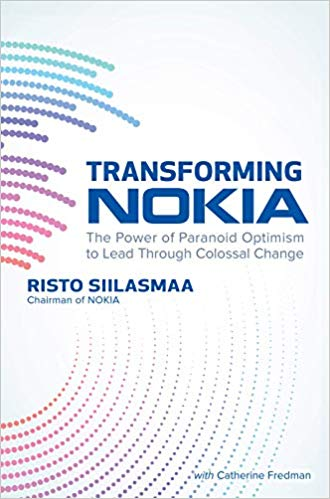Transforming Nokia
The Power of Paranoid Optimism to Lead Through Colossal Change


Risto Siilasmaa is the founder and former CEO of Finnish anti-virus and computer security firm F-Secure. He has been a board member of Nokia since 2008, becoming Chairman in 2012, and was interim CEO for eight months between 2013-14 on the departure of Stephen Elop.
Nokia is well-known as the company that spectacularly lost its dominant position as a mobile phone manufacturer by failing to recognize the change that Apple’s iPhone brought to the market. Along with Kodak and Blockbuster it is frequently cited as one of the great corporate failures of the digital age. But unlike Kodak and Blockbuster, Nokia has resurrected and reinvented itself – as one of the top players in the global digital communications infrastructure market. The company is a very different one to what it was….but then it started out making wood pulp in 1865, before going into cables and rubber boots manufacture and eventually mobile phones. So radical change has always been in its DNA perhaps.
Risto Siilasmaa, the author, joined the Nokia board in 2008 at the peak of that company’s fame and fortune. As the junior board member he admits he was overawed by the position and felt unable to fully influence the discussions, and was uncomfortable with the seemingly detached and mechanistic procedure of board discussions. It was all very formal, traditional and elitist with private jets and chauffeured limos for board members, and everything tightly controlled by the then chairman Jorma Ollila, the pre-eminent leader of the business, having also been its CEO.
With Apple’s introduction of the iPhone the game changed but the Nokia board failed to understand its implications. Worse, they failed to ask the difficult questions of the management that would have unveiled the real issues: a fragmented operating system leading to very cumbersome and expensive development to make any changes across their suite of devices – in sharp contrast to iOS and later Android operating systems. The board in its detachment and insistence on not being ‘operationally’ involved could not ask the right questions, they lacked the mindset to ask ‘why?’ rather than ‘what?’, there was no individual or collective curiosity in why products were overdue and financials forecasts relentlessly failing to be met. The hubris of success in the diminishing basic phone business clouded out disastrous legacy issues that were to bring about the collapse of their smartphone business.
Siilasmaa makes much of his entrepreneurial background. He replaced Ollila as chairman in 2012 just as the perfect storm of failure fully hit the company. Through his 10-point Entrepreneurial Leadership approach, which is founded on his philosophy of ‘paranoid optimism’, he then set about re-aligning the company as the context kept shifting around him. Anyone who has run a small business will immediately understand the concept of paranoid optimism, the incessant, habitual calculating of downside risk (as small companies have little capacity for significant failure) while maintaining a true belief in future success, combined with inordinate quantities of resilience.
Siilasmaa brought this to the multi-billion dollar Nokia, as its woes mounted. The Finnish quality of ‘sisu’ that helps them get through the long dark winters with determination and tenacity also played its part. The book highlights that the big decisions having to be taken are little different from those made in smaller organizations, it is just more complex to gather the diverse, fragmented data to make clear decisions in large businesses. What Siilasmaa strongly advocates is a very human approach.
He characterises Ollila’s tenure as one of centralised command and control where information was filtered and channelled, while his approach was diametrically opposed being founded on being open and transparent. Bad news was championed as it allowed issues to be understood and foreseen.
This book is valuable on a host of levels. It analyses a massive corporate failure from an inside perspective, (though Ollila has criticised the analysis); it shines a rare light on the actual workings of corporate boards (the reality of the paucity of information, insight and influence board members have); and it sets out a real-world exemplar for how modern, caring, communicative management can work to keep even large organizations agile and innovative while navigating complexity. The role of being human is central. Siilasmaa says he tries to get the board to laugh within the first 10 minutes of a meeting, as it sets a tone where honesty and trust can flourish…and this leads to being better prepared for all scenarios that business brings.
Transforming Nokia is a fast-moving business case study with a thriller-like selection of twists and turns as the company’s options dwindle and change, but the real value is in Siilasmaa’s ‘entrepreneurial leadership’ approach and the strong emphasis he puts on human relationships between management and workers, between colleagues, and between negotiating parties.
Title: Transforming Nokia, The Power of Paranoid Optimism to Lead Through Colossal Change
Author/s Name/s: Risto Siilasmaa (with Catherine Fredman)
Publisher: McGraw-Hill Education
ISBN: 978-1-260-12873-4
Publishing Date: November, 2018
Number of Pages: 293
Author Knowledge Rating: 1-5 (based on their years of experience, academic expertise in subject areas, and exposure to cross-functional thinking in the area)





















































































Readability: 1-5 score(1=dense and v academic; 5=frantic; page turner)









































































































Appropriate Length: (1=could have been written in 25% of the length;5=could have been longer)









































































































Core Idea Value: (1=nonsense (or entirely esoteric); 5=game-changer)








































































































